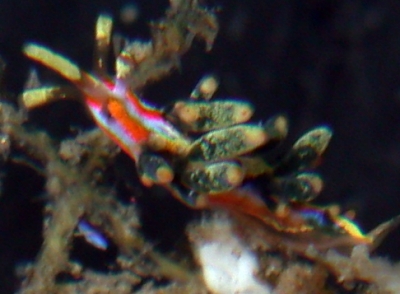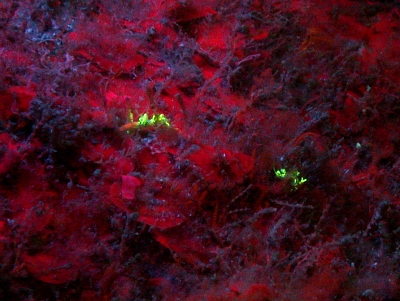Cuthona millenae from the tropical eastern Pacific
August 6, 2007
From: Alicia Hermosillo


Dear Bill,
As I mentioned in the reference to the publication where this and other aeolids are described, we had only two specimens of Cuthona millenae until my colleague and coral expert Pedro Medina and I started using flourescent filters [mesage #20286]and discovered that Cuthona millenae glows neon yellow and is apparently all over the place.
We now know it from various locations in the Mexican Pacific including the oceanic islands of Revillagigedo.
Locality: Islas Revillagigedo, 65 feet, Colima, Mexico, tropical eastern Pacific, 12 April 2007, Rocky subtidal. Length: 5 mm. Photographer: Ali Hermosillo.
I know it is a bit of a stretch, the close-up is not as tight because my fluo pictures still leave a lot to desire for, but I guess this one illustrates what can be seen.
Cheers
Ali
gueri25@hotmail.com
Hermosillo, A., 2007 (Aug 6) Cuthona millenae from the tropical eastern Pacific. [Message in] Sea Slug Forum. Australian Museum, Sydney. Available from http://www.seaslugforum.net/find/20387
Dear Ali,
I must say the normal colour of this animal is quite spectacular, even without the fluorescence. I often wonder why such small animals have such brilliant and complex colour patterns considering that they can't see and you would think that if you were warning predators, a simple bold design would be simpler.
Fluorescence is a whole new area of research. It has hit the public attention I guess because scientists transferred a jellyfish gene for fluoresence into a mouse. Their aim was not just to make glowing mice but to prove gene transfer between species was possible - just as you are using fluorescence to find cryptic nudibranchs. It does raise the question of why these nudibranchs fluoresce. I think the first discovery of flourescing animals was in some Australian parrots and its now thought they use it in communication - but that's a bit of guess I think. But it is now known to be quite widespread in marine animals including corals and other cnidarians, crustaceans, squid and who knows what else. Whatever its role is in the lives of those that have it, it is certainly a bonus for nudibranch hunters.
Best wishes,
Bill Rudman
